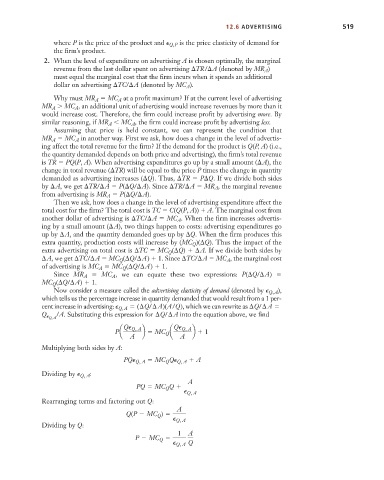Page 545 - Microeconomics, Fourth Edition
P. 545
c12capturingsurplus.qxd 7/22/10 10:41 AM Page 519
12.6 ADVERTISING 519
where P is the price of the product and Q,P is the price elasticity of demand for
the firm’s product.
2. When the level of expenditure on advertising A is chosen optimally, the marginal
)
revenue from the last dollar spent on advertising TR/ A (denoted by MR A
must equal the marginal cost that the firm incurs when it spends an additional
dollar on advertising TC/ A (denoted by MC ).
A
Why must MR MC at a profit maximum? If at the current level of advertising
A
A
MR MC , an additional unit of advertising would increase revenues by more than it
A
A
would increase cost. Therefore, the firm could increase profit by advertising more. By
similar reasoning, if MR MC , the firm could increase profit by advertising less.
A
A
Assuming that price is held constant, we can represent the condition that
MR MC in another way. First we ask, how does a change in the level of advertis-
A
A
ing affect the total revenue for the firm? If the demand for the product is Q(P, A) (i.e.,
the quantity demanded depends on both price and advertising), the firm’s total revenue
is TR PQ(P, A). When advertising expenditures go up by a small amount ( A), the
change in total revenue ( TR) will be equal to the price P times the change in quantity
demanded as advertising increases ( Q). Thus, TR P Q. If we divide both sides
by A, we get TR/ A P( Q/ A). Since TR/ A MR , the marginal revenue
A
from advertising is MR P( Q/ A).
A
Then we ask, how does a change in the level of advertising expenditure affect the
total cost for the firm? The total cost is TC C(Q(P, A)) A. The marginal cost from
another dollar of advertising is TC/ A MC . When the firm increases advertis-
A
ing by a small amount ( A), two things happen to costs: advertising expenditures go
up by A, and the quantity demanded goes up by Q. When the firm produces this
extra quantity, production costs will increase by (MC )( Q). Thus the impact of the
Q
extra advertising on total cost is TC MC ( Q) A. If we divide both sides by
Q
A, we get TC/ A MC ( Q/ A) 1. Since TC/ A MC , the marginal cost
A
Q
of advertising is MC MC ( Q/ A) 1.
Q
A
Since MR A MC , we can equate these two expressions: P( Q/ A)
A
MC ( Q/ A) 1.
Q
Now consider a measure called the advertising elasticity of demand (denoted by Q,A ),
which tells us the percentage increase in quantity demanded that would result from a 1 per-
cent increase in advertising: Q,A (¢Q/¢ A)(A/Q), which we can rewrite as ¢Q/¢ A
Q /A. Substituting this expression for ¢Q/¢ A into the equation above, we find
Q, A
Q Q, A Q Q, A
Pa b MC a b 1
Q
A A
Multiplying both sides by A:
PQ Q, A MC Q Q, A A
Q
Dividing by Q, A :
A
PQ MC Q
Q
Q, A
Rearranging terms and factoring out Q:
A
Q(P MC )
Q
Q, A
Dividing by Q:
1 A
P MC
Q
Q, A Q

